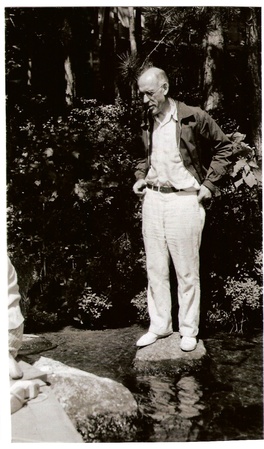
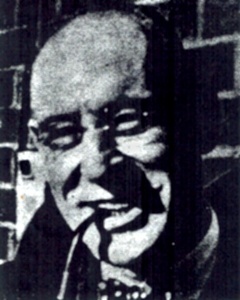 From the Obituary of Dr. Leroy Upson Gardner, provided by a family member in 2012. Source unknown. Born: December 9, 1888, Meriden, Connecticut
From the Obituary of Dr. Leroy Upson Gardner, provided by a family member in 2012. Source unknown. Born: December 9, 1888, Meriden, Connecticut
Died: October 24, 1946, Saranac Lake
Married: Carabel McKenzie
Children: Two daughters: Mrs. Benjamin (Dorothy) Downs and Mrs. Frederick Levering (Margaret) Neely
 Saranac Lake and the Olympics. 1932, Currier PressDr. Leroy Upson Gardner was the director of the Saranac Laboratory from 1927-1946, and a researcher who did pioneering work on pneumoniconiosis and silicosis. He started at the Trudeau Foundation in 1919 as a pathologist, and became director of the Lab in 1927. During 32 years of research he found means of curbing silicosis in mines and factories, and showed how silicosis related to tuberculosis, work for which he received the Trudeau Medal in 1935. Gardner received an A.B. from Yale University in 1912, and an M.D. in 1914. He was an instructor in pathology at Harvard University in 1916-1917. He served as Director of the National Tuberculosis Association.
Saranac Lake and the Olympics. 1932, Currier PressDr. Leroy Upson Gardner was the director of the Saranac Laboratory from 1927-1946, and a researcher who did pioneering work on pneumoniconiosis and silicosis. He started at the Trudeau Foundation in 1919 as a pathologist, and became director of the Lab in 1927. During 32 years of research he found means of curbing silicosis in mines and factories, and showed how silicosis related to tuberculosis, work for which he received the Trudeau Medal in 1935. Gardner received an A.B. from Yale University in 1912, and an M.D. in 1914. He was an instructor in pathology at Harvard University in 1916-1917. He served as Director of the National Tuberculosis Association.
 A brick at the Saranac Laboratory has been dedicated in the name of Leroy Upson Gardner by his grandson, Thomas Downs. In 1995, Dr. Gerrit W. H. Schepers published an article in the American Journal of Industrial Medicine, Chronology of Asbestos Cancer Discoveries: Experimental Studies of the Saranac Laboratory. The article details Dr. Gardner's research into the effects of asbestos on the lung. In the article, Dr. Schepers wrote, "Dr. Le Roy Upson Gardner was the doyen research pioneer and wholly incorruptible scientist of American experimental pneumoconiology. He also was an experienced and very thorough, but conservative, pathologist who never made any judgment unless absolutely convinced of his facts. Most of his studies were repeated many times with multiple variations to get at the truth. My interpretation is that Gardner had found in 1942 that the majority of the mouse tumors were truly malignant."
A brick at the Saranac Laboratory has been dedicated in the name of Leroy Upson Gardner by his grandson, Thomas Downs. In 1995, Dr. Gerrit W. H. Schepers published an article in the American Journal of Industrial Medicine, Chronology of Asbestos Cancer Discoveries: Experimental Studies of the Saranac Laboratory. The article details Dr. Gardner's research into the effects of asbestos on the lung. In the article, Dr. Schepers wrote, "Dr. Le Roy Upson Gardner was the doyen research pioneer and wholly incorruptible scientist of American experimental pneumoconiology. He also was an experienced and very thorough, but conservative, pathologist who never made any judgment unless absolutely convinced of his facts. Most of his studies were repeated many times with multiple variations to get at the truth. My interpretation is that Gardner had found in 1942 that the majority of the mouse tumors were truly malignant."
Dr. Gardner lived in Saranac Lake from 1917-1946. His residence was 36 Old Military Road. He died of a heart attack.He is buried in the cemetery at St. John's in the Wilderness Episcopal Church.
Alice Wareham recalled calling Dr. Gardner "Uncle Roy" and his wife, "Aunt Carabel." There was a wildflower contest in the spring run for the Baldwin School children. Mrs. Leonard was surprised when Alice found what she thought was a yellow trillium, and didn't believe her. Instead of saying, "you're wrong", Dr. Gardner said, "show it to me." She did, and he confirmed that it was a rare mutation of a yellow trillium.
Lillian Blinn was his long-time secretary.
New York Times, 10/24/46, from a partially illegible photocopy
DR. GARDNER DIES; SILICOSIS EXPERT
Leader in Research on Disease Headed Saranac Laboratory—Won Several Awards
SARANAC LAKE, N.Y., Oct. 24—Dr. Leroy Upson Gardner, director of the Saranac Laboratory and the Trudeau Foundation, an international leader in the research of silicosis and other industrial diseases, died here this morning in his home. His age was 57.
At his death Dr. Gardner was in the midst of a program for the expansion of the laboratory and the development of a $1,000,000 medical center in Saranac Lake. He had raised more than $100,000 for an addition to the laboratory and was planning for the development of the medical center. As a director of the Trudeau Foundation, he was also interested in the expansion program planned for Trudeau Sanatorium that will call for an expenditure of more than $1,000,000.
Dr. Gardner leaves a widow, the former Carabel Mackenzie, whom he married in June, 1915, and two daughters, Mrs. Benjamin Downs of Washington, D.C. and Mrs. F. Levering Neely of Atlanta, Ga.
Won Knudson Award in 1940
Dr. Gardner received in 1940 the William S. Knudson Award for his research on the control of silicosis, which was credited with determining what takes place in a workman’s lung as a result of breathing silicon dust and with making possible the prescription of preventive measures for improving(?) the plants. In 1935 he received the Trudeau Medal for important work in the pathology of tuberculosis and the relation between tuberculosis and silicosis.
As director of the Saranac Lake laboratory, Dr. Gardner used the facilities in seeking answers to questions he posed as a medical student: “Why are some stone cutters in the Barre, Vt. granite quarries highly susceptible to tuberculosis? And why, in the near-by Proctor, Vt. marble quarries, are the cutters not similarly affected?"
He began his investigations in 1914. Twenty-six years later his research had made him an international authority on the subject. Silicosis research took Dr. Gardner to industrial plants and mines throughout the nation.
Born in New Brittain, Conn., to Irving Isaac and Inez Baldwin Upson Gardner, he received his B.A. degree in 1912 and an M.D. degree in 1914 from Yale, and took post graduate work at Boston City Hospital and Harvard Medical School from 1914 to 1917.
Taught at Harvard and Yale
During the First World War, Dr. Gardner served as a lieutenant in the Army Medical Corps in 1917. He was instructor in pathology at Harvard Medical School in 1915-17, and assistant professor of pathology, Yale School of Medicine, 1917-18.
In 1919 he became pathologist of the Trudeau Foundation at Saranac Lake. He was appointed director of the Saranac Laboratory in 1937 and director of the foundation and Trudeau School in 193?. He was a trustee of the Village of Saranac Lake in 1932-33, a member of the water board in 1929 and a member of the Village Planning Commission.
In 1940 he received an honorary M.S. degree from Yale. He was author, with S.A.—- (?) [possibly S. A. Petroff] “Tuberculosis—Bacteriology, Pathology and Laboratory Diagnosis," and contributed to medical publications on silicosis and related diseases due to (illegible).
From: “They Rebuild Men” by Eleanor Dayton Partial transcription from a partial photocopy, page 10, source unknown, apparently 1941.
They're the staff of the Saranac Laboratory. Desiring to take their place in the world despite the handicap of tuberculosis, they have become research workers, whose honest and often spectacular attainments are internationally known.
They are quietly at work on the research problem of tuberculosis and of silicosis and other dust diseases. They are quietly proving, also, though they're unaware of it, that Saranac Lake is an A-No. 1 spot for rehabilitation of the patient.
They've all had tuberculosis. They're united in their interest in its care and cure. Not doctors of medicine, they all see in laboratory work a way of further defeating a disease which each day, through their efforts, grows less formidable.
They're largely self-taught, though as one learns his profession, he gives his help to the next.
Their director is Dr. Leroy U. Gardner, world authority on silicosis. Dr. Gardner came to Saranac Lake because he had tuberculosis. He had been an assistant professor of pathology at Yale.
He loaned his knowledge and experience and interest to a new job here. That’s what all the men and women under him are doing, too.
He disclaims it, but he must be a great boss. In connection with every one of the staff he says, “I don’t know how I could manage without him. He does such-and-such ever so much better than I could.”
From an unknown source (probably Canadian) provided by a family member in 2012:
OBITUARY
LEROY UPSON GARDNER
It is with deep regret that we record the death of Leroy Upson Gardner at Saranac Lake on October 24, 1946, at the comparatively early age of 57. He was born in New Britain, Connecticut, and began his medical career at Yale, where he took his B.A. in 1912 and his M.D. in 1914. He then went to Boston and worked in the Havard Medical School at the Boston City Hospital, and during 1916-17 he was instructor in pathology. He joined the U.S. Army Medical Corps in 1917 as a lieutenant, but in 1918 he became assistant professor of pathology at Yale. Then in 1919 he was appointed pathologist to the Trudeau Foundation at Saranac Lake, and subsequently and successively director of the Saranac Laboratory in 1927 and director of the foundation and Trudeau School in 1938. He was a member of the corresponding committee on silicosis of the International Labour Office at Geneva, a Fellow of the American Association for Advancement of Science, a member of the American Association of Pathologists, a director of the National Tuberculosis Association, and a member of the Council on Industrial Health of the American Medical Association. He received the Trudeau Medal in 1935 for his work on the pathology of tuberculosis and the relationship between tuberculosis and silicosis. In 1940 he received an honorary M.S. degree from Yale, and in the same year won the William S. Knudsen Award for his research on the control of silicosis.
To the many Englishmen who have visited Saranac Lake, he will always be remembered for his great hospitality, courtesy, and kindness. The picture which we reproduce is characteristic of him with his pipe and was taken shortly before his death. He is most famous for his work on silicosis, which started when he was a medical student. He sought an answer to the question : 'Why are some stone cutters in the Barre, Vermont granite quarries highly susceptible to tuberculosis; while in the nearby Proctor, Vermont marble quarries the cutters are not similarly affected ?' He began his investigations in 1922, and in the next year published (Amer. Rev. Tuberc., 1923, 7, 344) the results of his classic experiment with the finely divided powder of carborundum (silicon carbide), which failed to produce silicosis despite the sharp-edged nature of its particles. He soon became an international authority on the subject. He reported unequivocally that the inhalation of metallic aluminium and hydrated aluminium oxide—XH 1010—protects animals against the development of silicosis (J. industr. Hyg., 1944, 26, 211). This finding necessitates a therapeutic trial in man.
At the time of his death, Dr. Gardner was engaged on an expansion scheme for his laboratory and the development of a million dollar medical centre at Saranac Lake; he had already raised more than a hundred thousand dollars for the project. He was also interested in the expansion programme planned for the Trudeau Sanatorium. He will be sadly missed in the fields both of silicosis and tuberculosis.
Dr. Gardner leaves a widow, Carabel McKenzie, whom he married in June, 1915, and two daughters, Mrs. Benjamin Downs of Washington, D.C., and Mrs. F. Levering Neely of Atlanta, Georgia.
—K. M. A. P.
Gardner Documents in possession of grandson, John Neely include:
- List of Publications of Leroy Upson Gardner, M.D., from 1917 to 1946, numbering 108, plus numerous publications of Saranac Laboratory during this period; on such subjects as tuberculosis, silicosis, mineral dust effect in humans and animals, industrial and mining respiratory diseases, and asbestos. Actual publications not found among materials.
- Large scrapbook of photos, pamphlets and materials on LUG’s 1930 trip to South Africa, to attend international silicosis conference, by ship around Africa through Suez Canal, with start and stop in London.
- Reprints of 4 part series of in-depth articles from The New Yorker magazine from 1985, entitled ANNALS OF LAW: The Asbestos Industry of Trial. Part 2 of the series discusses role Dr. Gardner and the Saranac Lab played in private research on effects of asbestos for the asbestos industry. (From the 1930s into the 1960s asbestos was routinely mined and used in the manufacture of construction materials, insulation and ship building. Miners and construction workers began to develop lung disease and cancer in the 1960s and 1970s, and tens of thousands of lawsuits were filed against the asbestos industry. Fortune 500 manufacturer Johns-Manville Corporation declared bankruptcy in 1982, under the weight of existing and future lawsuits. In numerous trials, Mansville said that they did not have evidence until 1964 that asbestos may cause lung cancer, covering up evidence they had in the 40s and 50s that asbestos may in fact have caused lung disease. Dr. Wil Downs, husband of Dorothy Gardner Downs, in a letter dated June 21, 1985, transmitting copies of the articles to Dr. Levering Neely (husband of Margaret Gardner Neely), notes a statement in the article that in 1936 Dr. Gardner accepted a $5,000 per year for 3 year grant from Johns-Manville, for support of research work on asbestosis, to be carried out at the Saranac Lake Laboratory. In letter dated Nov. 23, 1936 Dr. Gardner acknowledges the corporation’s right of approval over any reports prior to publication. Financing apparently expanded to $30,000 over 7 years through Asbestos Association.)
- Bound and tabbed notebook entitled SARANAC LAKE REBUTTAL, with copies of correspondence between Dr. Gardner and Johns-Manville Corporation, which must have been part of the Corporation’s defense in the 1980s trials. Much of the research is described, though the actual research results are not in the notebook. In a 1943 letter to Johns-Manville Dr. Gardner states “The question of cancer susceptibility now seems more significant than I had previously imagined.” “These observations are suggestive but not conclusive of a cancer stimulating action by asbestos dust.” “It is hoped that this experiment can be repeated under properly controlled conditions to determine whether asbestos dust actually favors cancer of the lung.” In 1943 Dr. Gardner applies to the National Cancer Institute for more funding to confirm and expand preliminary findings from privately funded research studies, but is turned down. No final report of the Saranac Lab’s asbestosis studies sponsored by the asbestos industry is prepared until 1951, five years after Dr. Gardner’s death in October of 1946.
- With other letters and photographs, are hand written notes, partially illegible/damaged, by Dr. Levering Neely (husband of Margaret Gardner Neely), summarizing much of the Saranac Lake Rebuttal and the New Yorker Magazine articles. Dr. Gardner’s obituary was found in the SARANAC LAKE REBUTTAL.
- Bound Resolution from the Industrial Hygiene Foundation of America, Inc., date November 7, 1946, recognizing Dr. Gardner’s many contributions to improving the health of industrial workers. He “devoted his life and talents to the cure of illness of others and the correction and control of industrial hazards to enable his Fellowman to have better and safer conditions under which to perform their daily tasks.”
- Meridan High School annuals, 1904 and 1907.
- History of the Class of 1912, Volume One, Yale College
- Class of Yale College 1912, Decennial Record (1923)
- III Olympic Winter Games, Lake Placid 1932; pictures and details from the games.
- High School scrap book of Margaret Gardner (Neely)
See also: "Repressions," a set of limericks about the doctors by Mildred Blanchet, posted at the bottom of her page.
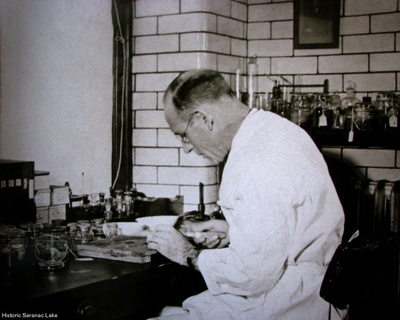 Leroy Upson Gardner working in the Saranac Laboratory
Leroy Upson Gardner working in the Saranac Laboratory 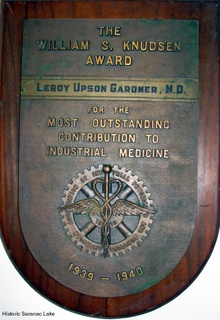 William S. Knudson Award
William S. Knudson Award 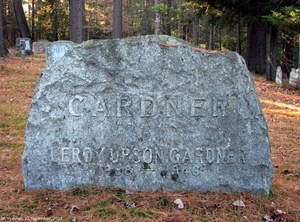 St. John's in the Wilderness Episcopal Church
St. John's in the Wilderness Episcopal Church
There is a photograph showing cross sections of post-mortem lungs in glass jars being discussed by Dr. Leroy Gardner and Dr. Arthur J. Vorwald here. (Photo by Alfred Eisenstaedt/The LIFE Picture Collection via Getty Images) [This was probably taken at the Trudeau Sanatorium, not the Saranac Laboratory, judging by the space and the surroundings. MaryBHotaling]
Sources:
-
Information provided by his grandson, Thomas L. Downs, 2009.



